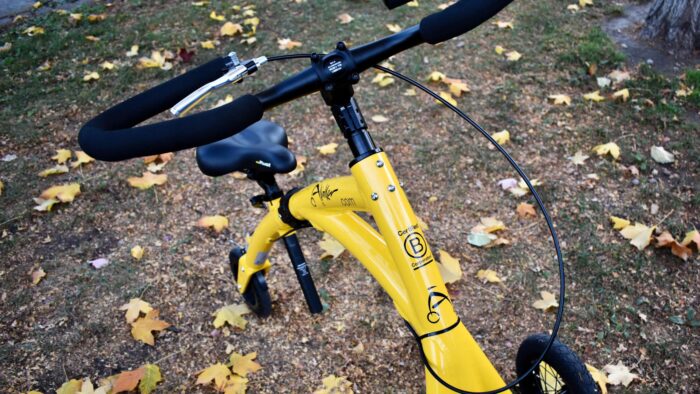In this guest post, friend of Bike Ottawa AnaLori Smith recounts the many ways which her adaptive bike and the NCC’s Active Use program have benefited her.
Emotionally, Physically, and Spiritually: Building the Most Empowered Version of Myself with the Alinker Walking Bike
My name is AnaLori Smith and I am an adaptive cyclist. I’ve been an adaptive cyclist since my childhood, using a variety of bikes. My first and second bikes were a hand cycle and a recumbent cycle. My third and current bike is the Alinker, a non-motorized walking bike without pedals. My sunny yellow walking bike keeps my body agile and empowered as a woman with cerebral palsy. My emotional, physical, and spiritual health have greatly improved since purchasing my Alinker in September 2022.
When I first moved to Centretown from the suburbs in 2015, I stopped cycling. The move changed the landscape of my bike rides. Emotionally and physically, I felt unsafe as an adaptive cyclist in Centretown. This is because the bike lanes do not meet the principles of universal design—in other words, an environment that can be accessed by every body regardless of ability, age, or size. When the built environment is accessible and barrier-free, every body benefits. With my daily road biking routine paused, my emotional, physical, and spiritual fitness spiralled downward. My body was unable to keep up with my blooming career in the Federal Public Service or with my circle of friends. Anxiety, chronic fatigue, chronic pain, and depression defined my inactive standpoint from the sidelines.
Then one day, while people-watching in the neighbourhood, I spotted a middle-aged woman confidently and gracefully cycling with a brightly coloured bicycle. The bicycle and her body moved as one while propelling uphill. The sidewalk acted as a safe bike path. My imagination opened up while watching the Crayola coloured bicycle glide along the sidewalk. I returned home and researched “yellow walking bike”. A Canadian design, the Alinker is a radical rethink of disability and mobility. The bike is a hybrid between a walker and a wheelchair. Unlike most mobility aids, the Alinker enables empowered mobility and is designed to be aesthetically cheerful. Without the fear of falling, the cyclist can do cardio, mobility, and strength training.
At that point, my body was shutting down and my wheelchair was no longer dependable. Chronic fatigue and pain in my ankles and my joints disabled my ability to bear my body weight. My ability to live independently was in doubt, and that’s when I purchased the Alinker online. I remember feeling fearful. Fear of not being good enough. Fear of not being the embodied athlete as seen on the Alinker’s website. As a physically disabled woman, my bodily autonomy and living independently are essential to my wholeness. My only options were to “ride or die”.
The bike arrived on September 30th, 2022. My daily routine included 30 minutes of walking up and down the hallway of my apartment building with the Alinker. By November, I strolled down Elgin Street three, four, then five times per week. My chronic fatigue and pain began to ease. My response time to pedestrians and vehicles sped up. In late autumn, my emotional and physical safety were my top priority. Barriers in the built environment included inaccessible bike paths, early evening darkness, and street harassment as an active woman in public space. In the empty parking lot of the Canadian Museum of Nature, I biked between 5:30 to 6:30 PM until the Winter Solstice. I picked the parking lot because it is close to home, close to pedestrians in case of an emergency, as well as excellent outdoor lighting and snow removal. While the freedom of my new route was limited, the safety of the built environment was limitless. During the winter months, I biked in above and below ground parking to build up my body’s mobility and strength.
Victoria Weekend arrived and I read about the National Capital Commission’s (NCC) Weekend Bikedays. Each weekend from May to October, the NCC reserves its prime parkways for active transportation. Accessible by default and barrier-free, the NCC’s Weekend Bikedays meet the principles of universal design. The proactive removal of barriers in the built environment opened doors for myself and my sunny yellow walking bike. What I noticed from my first ride was the minimal strain on my body. My back and my hamstring muscles were being worked, but not overworked as per usual. Secondly, I noticed the mixed demographic of the cyclists. I spotted other adaptive cyclists, seniors, and toddlers along the parkway. Lycra wearing cyclists sped past everybody from a safe distance. The spatiality of the parkway, as well as the full separation from vehicles, enabled every body to cycle without compromising freedom or safety. In the summertime, the Queen Elizabeth Parkway is reserved for active transportation, seven days per week, from eight to eight through its Active Use program. Since using the parkway daily, I have noticed significant improvements in my balance, fine motor skills, and muscle mass. I use my standing desk part time at work, and I independently clean my home every second week. This summer I am planning a solo trip to Toronto, my first solo trip since 2019. I trust my body to travel safely. The Alinker is so much more than active transportation or mobility and strength training. My sunny yellow bicycle is an extension of my body. The extension of my body that enabled me to build the most empowered version of myself – emotionally, physically, and spiritually.

